人教版(2019)必修 第二册Unit 3 The internet Reading for Writing 课件(22张PPT)
文档属性
| 名称 | 人教版(2019)必修 第二册Unit 3 The internet Reading for Writing 课件(22张PPT) | 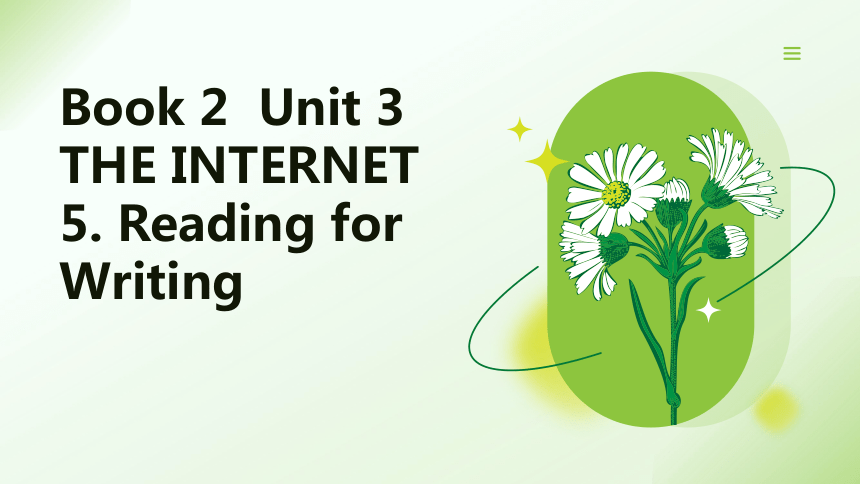 | |
| 格式 | pptx | ||
| 文件大小 | 4.2MB | ||
| 资源类型 | 教案 | ||
| 版本资源 | 人教版(2019) | ||
| 科目 | 英语 | ||
| 更新时间 | 2024-10-20 12:37:29 | ||
图片预览

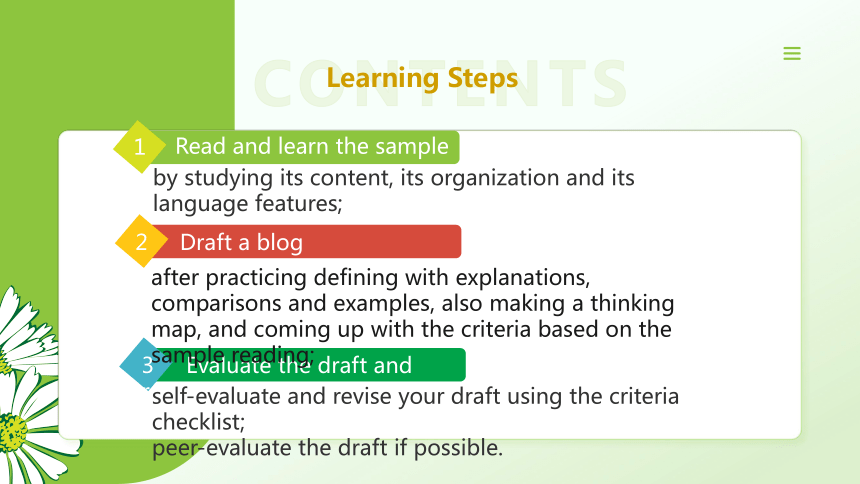
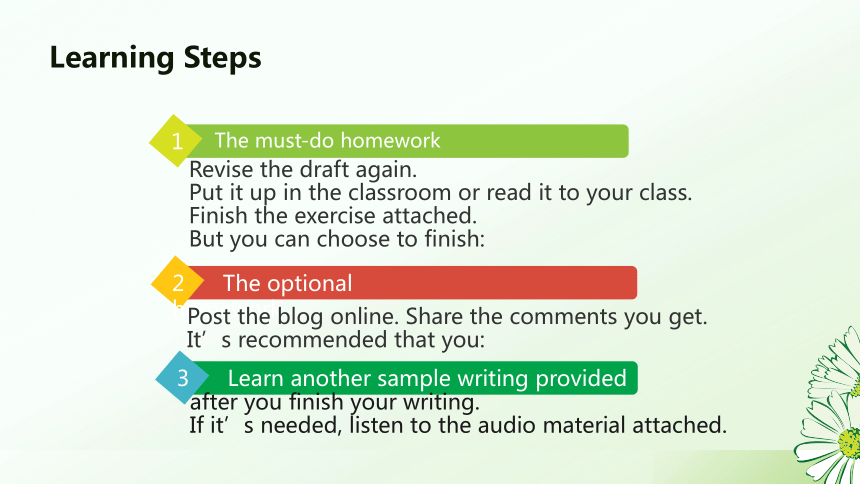
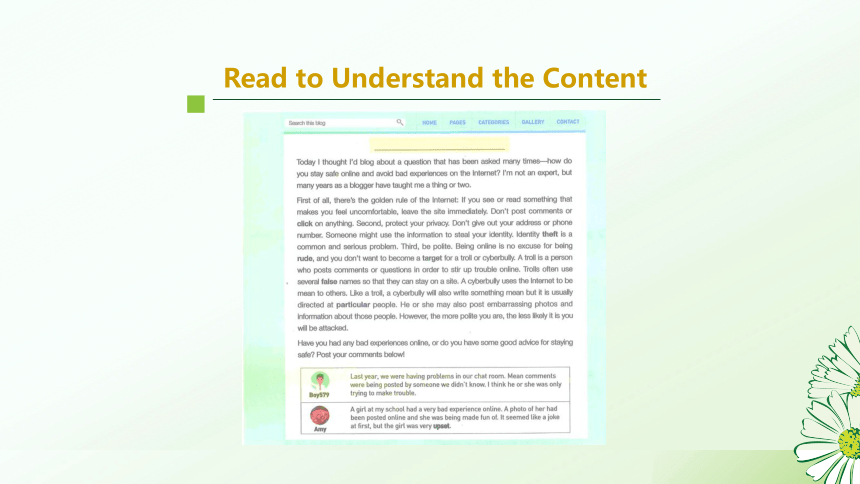
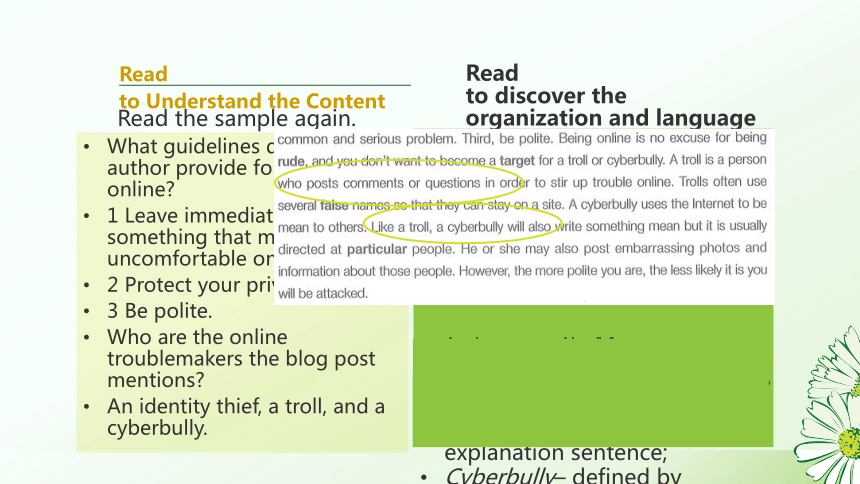
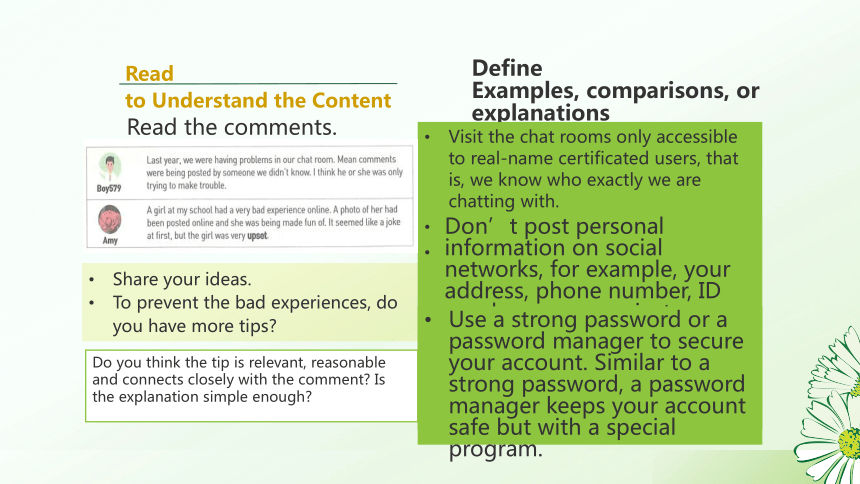
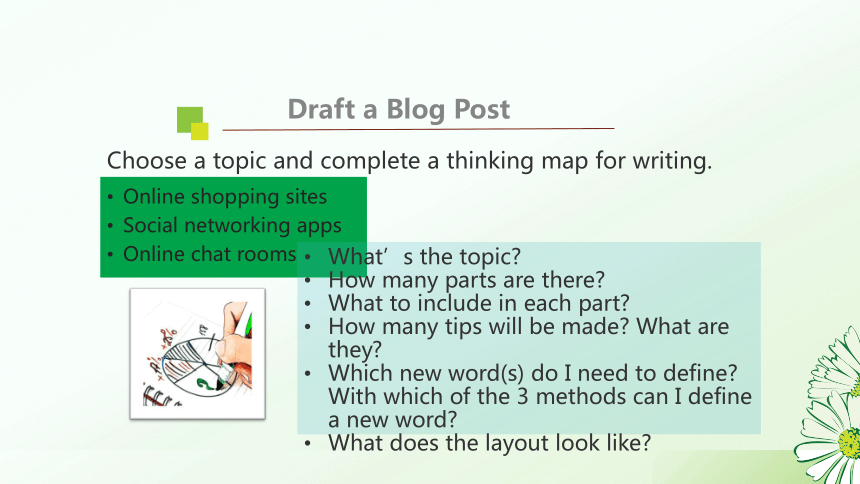
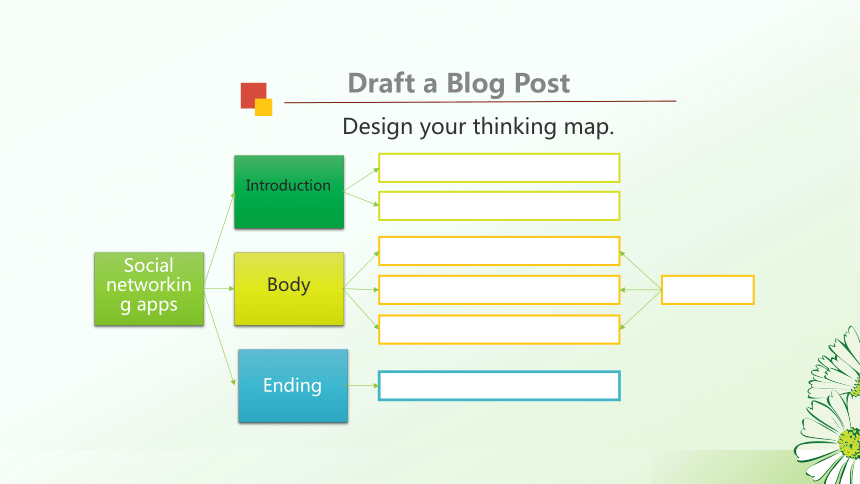
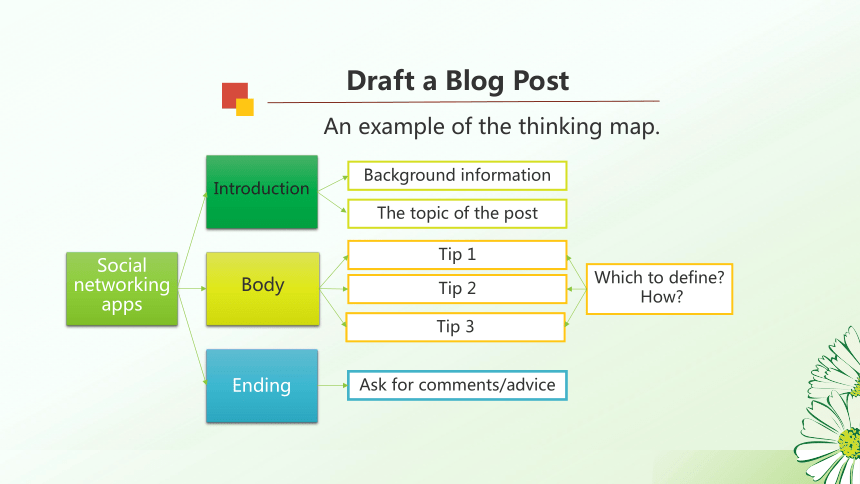
文档简介
(共22张PPT)
Book 2 Unit 3 THE INTERNET
5. Reading for Writing
1
by studying its content, its organization and its language features;
3 Evaluate the draft and revise
self-evaluate and revise your draft using the criteria checklist;
peer-evaluate the draft if possible.
2 Draft a blog
after practicing defining with explanations, comparisons and examples, also making a thinking map, and coming up with the criteria based on the sample reading;
Learning Steps
Read and learn the sample
1
Revise the draft again.
Put it up in the classroom or read it to your class.
Finish the exercise attached.
But you can choose to finish:
3 Learn another sample writing provided
2 The optional homework
Post the blog online. Share the comments you get.
It’s recommended that you:
The must-do homework
after you finish your writing.
If it’s needed, listen to the audio material attached.
Learning Steps
Read to Understand the Content
Read
to discover the organization and language features
What words and phrases does the writer use to organize the guidelines
First of all; Second; Third.
What similar expressions do you know
Firstly; Secondly; Thirdly; Finally.
On the one hand,….On the other hand….
To begin with; Moreover; Finally.
What new words are explained How
Troll – defined with an explanation sentence;
Cyberbully– defined by comparing.
Read
to Understand the Content
What guidelines does the author provide for staying safe online
1 Leave immediately if you find something that makes you feel uncomfortable on the site.
2 Protect your privacy.
3 Be polite.
Who are the online troublemakers the blog post mentions
An identity thief, a troll, and a cyberbully.
Read the sample again.
Define
Examples, comparisons, or explanations
Share your ideas.
To prevent the bad experiences, do you have more tips
Visit the chat rooms only accessible to real-name certificated users, that is, we know who exactly we are chatting with.
Try to write.
Don’t post personal information on social networks, for example, …
Use a strong password or a password manager to secure your account. Similar to a strong password, …
Read
to Understand the Content
Read the comments.
Don’t post personal information on social networks, for example, your address, phone number, ID number or your private photos.
Use a strong password or a password manager to secure your account. Similar to a strong password, a password manager keeps your account safe but with a special program.
Do you think the tip is relevant, reasonable and connects closely with the comment Is the explanation simple enough
Draft a Blog Post
Choose a topic and complete a thinking map for writing.
Online shopping sites
Social networking apps
Online chat rooms
What’s the topic
How many parts are there
What to include in each part
How many tips will be made What are they
Which new word(s) do I need to define With which of the 3 methods can I define a new word
What does the layout look like
Draft a Blog Post
Design your thinking map.
Social networking apps
Body
Introduction
Ending
Draft a Blog Post
An example of the thinking map.
Social networking apps
Body
Introduction
Ending
Background information
The topic of the post
Tip 1
Tip 2
Tip 3
Ask for comments/advice
Which to define
How
Draft a Blog Post
An example of the thinking map.
Social networking apps
Body
Introduction
Ending
Social networking apps enjoying popularity
The safety of social networking apps
Don’t post personal information.
Don’t believe everything you read.
Be polite.
Ask for comments/advice
comparison
cyberbully/troll
explanation
Pseudo-science
example photos
comparison
cyberbully/troll
Draft a Blog Post
Check your thinking map.
Social networking apps
Body
Introduction
Ending
Social networking apps enjoying popularity
The safety of social networking apps
Don’t post personal information.
Don’t believe everything you read.
Be polite.
Ask for comments/advice
Topic
3 parts
Outlined contents
Methods to define
explanation
Pseudo-science
example photos
Criteria
Look back at the sample blog post. Think or discuss with a partner.
What makes a good blog post
Tell the reader what you know about the topic.
The tips and suggestions are well organized.
The new words are defined.
The blog post includes examples, comparisons, or explanations.
The contents are relevant, reasonable, simple and interconnected in logic.
End the blog post by asking readers to leave comments and/or suggestions.
Make no grammar or spelling mistakes.
If you write instead of typing, show good and clean handwriting.
Draft a Blog Post
It’s your turn to write independently!
Body
Introduction
Ending
Self-evaluation
Use the checklist to evaluate your own draft.
Items Yes or no If not, how to revise
Do I tell the reader what you know about the topic
Are the tips and suggestions well organized
Have I defined the new words
Do I include examples, comparisons, or explanations
Are the contents relevant, reasonable, simple and interconnected in logic
Do I end by asking readers to leave comments and/or suggestions
Can I find any grammar or spelling mistakes
Is my handwriting good and clean
Peer-evaluation
Items Yes or no If not, how to revise
Does the writer tell the reader what you know about the topic
Are the tips and suggestions well organized
Has the writer defined the new words
Does the author include examples, comparisons, or explanations
Are the contents relevant, reasonable, simple and interconnected in logic
Does the writer end by asking readers to leave comments and/or suggestions
Can you find any grammar or spelling mistakes
Is the author’s handwriting good and clean
If possible, exchange drafts with a partner. Use the checklist to help him/her revise the draft.
Evaluate and Revise
Use apps only accessible to real-name certificated users, which means we know who exactly we are connected to./The more polite you are, the less likely you are to be attacked.
controversial
√
√
√
ⅹ
√
√
So I want to offer some guidelines to social networking app users.
ⅹ
ⅹ
Summary
In the class, we have:
studied the content, the organization and language features of a blog post;
learnt and practiced 3 ways to define new words– examples, comparisons and explanations;
made a thinking map about the topic we choose to write about;
come up with the criteria of a good blog post;
drafted a blog post;
Self-evaluated, peer-evaluated and revised the draft.
Homework
You need to:
Revise the draft again. Put it up in the classroom or read it to your class.
Finish the exercise attached.
You can choose to:
Post the blog online. Share the comments you get.
Sample Writing
(教学素材出自《普通高中教科书英语(必修第二册)教师教学用书》,人民教育出版社,2019年7月,第132页及光盘)
Sample Writing
(教学素材出自《普通高中教科书英语(必修第二册)教师教学用书》,人民教育出版社,2019年7月,第132页及光盘)
Sample Writing
(教学素材出自《普通高中教科书英语(必修第二册)教师教学用书》,人民教育出版社,2019年7月,第132页及光盘)
Thank you very much!
Book 2 Unit 3 THE INTERNET
5. Reading for Writing
1
by studying its content, its organization and its language features;
3 Evaluate the draft and revise
self-evaluate and revise your draft using the criteria checklist;
peer-evaluate the draft if possible.
2 Draft a blog
after practicing defining with explanations, comparisons and examples, also making a thinking map, and coming up with the criteria based on the sample reading;
Learning Steps
Read and learn the sample
1
Revise the draft again.
Put it up in the classroom or read it to your class.
Finish the exercise attached.
But you can choose to finish:
3 Learn another sample writing provided
2 The optional homework
Post the blog online. Share the comments you get.
It’s recommended that you:
The must-do homework
after you finish your writing.
If it’s needed, listen to the audio material attached.
Learning Steps
Read to Understand the Content
Read
to discover the organization and language features
What words and phrases does the writer use to organize the guidelines
First of all; Second; Third.
What similar expressions do you know
Firstly; Secondly; Thirdly; Finally.
On the one hand,….On the other hand….
To begin with; Moreover; Finally.
What new words are explained How
Troll – defined with an explanation sentence;
Cyberbully– defined by comparing.
Read
to Understand the Content
What guidelines does the author provide for staying safe online
1 Leave immediately if you find something that makes you feel uncomfortable on the site.
2 Protect your privacy.
3 Be polite.
Who are the online troublemakers the blog post mentions
An identity thief, a troll, and a cyberbully.
Read the sample again.
Define
Examples, comparisons, or explanations
Share your ideas.
To prevent the bad experiences, do you have more tips
Visit the chat rooms only accessible to real-name certificated users, that is, we know who exactly we are chatting with.
Try to write.
Don’t post personal information on social networks, for example, …
Use a strong password or a password manager to secure your account. Similar to a strong password, …
Read
to Understand the Content
Read the comments.
Don’t post personal information on social networks, for example, your address, phone number, ID number or your private photos.
Use a strong password or a password manager to secure your account. Similar to a strong password, a password manager keeps your account safe but with a special program.
Do you think the tip is relevant, reasonable and connects closely with the comment Is the explanation simple enough
Draft a Blog Post
Choose a topic and complete a thinking map for writing.
Online shopping sites
Social networking apps
Online chat rooms
What’s the topic
How many parts are there
What to include in each part
How many tips will be made What are they
Which new word(s) do I need to define With which of the 3 methods can I define a new word
What does the layout look like
Draft a Blog Post
Design your thinking map.
Social networking apps
Body
Introduction
Ending
Draft a Blog Post
An example of the thinking map.
Social networking apps
Body
Introduction
Ending
Background information
The topic of the post
Tip 1
Tip 2
Tip 3
Ask for comments/advice
Which to define
How
Draft a Blog Post
An example of the thinking map.
Social networking apps
Body
Introduction
Ending
Social networking apps enjoying popularity
The safety of social networking apps
Don’t post personal information.
Don’t believe everything you read.
Be polite.
Ask for comments/advice
comparison
cyberbully/troll
explanation
Pseudo-science
example photos
comparison
cyberbully/troll
Draft a Blog Post
Check your thinking map.
Social networking apps
Body
Introduction
Ending
Social networking apps enjoying popularity
The safety of social networking apps
Don’t post personal information.
Don’t believe everything you read.
Be polite.
Ask for comments/advice
Topic
3 parts
Outlined contents
Methods to define
explanation
Pseudo-science
example photos
Criteria
Look back at the sample blog post. Think or discuss with a partner.
What makes a good blog post
Tell the reader what you know about the topic.
The tips and suggestions are well organized.
The new words are defined.
The blog post includes examples, comparisons, or explanations.
The contents are relevant, reasonable, simple and interconnected in logic.
End the blog post by asking readers to leave comments and/or suggestions.
Make no grammar or spelling mistakes.
If you write instead of typing, show good and clean handwriting.
Draft a Blog Post
It’s your turn to write independently!
Body
Introduction
Ending
Self-evaluation
Use the checklist to evaluate your own draft.
Items Yes or no If not, how to revise
Do I tell the reader what you know about the topic
Are the tips and suggestions well organized
Have I defined the new words
Do I include examples, comparisons, or explanations
Are the contents relevant, reasonable, simple and interconnected in logic
Do I end by asking readers to leave comments and/or suggestions
Can I find any grammar or spelling mistakes
Is my handwriting good and clean
Peer-evaluation
Items Yes or no If not, how to revise
Does the writer tell the reader what you know about the topic
Are the tips and suggestions well organized
Has the writer defined the new words
Does the author include examples, comparisons, or explanations
Are the contents relevant, reasonable, simple and interconnected in logic
Does the writer end by asking readers to leave comments and/or suggestions
Can you find any grammar or spelling mistakes
Is the author’s handwriting good and clean
If possible, exchange drafts with a partner. Use the checklist to help him/her revise the draft.
Evaluate and Revise
Use apps only accessible to real-name certificated users, which means we know who exactly we are connected to./The more polite you are, the less likely you are to be attacked.
controversial
√
√
√
ⅹ
√
√
So I want to offer some guidelines to social networking app users.
ⅹ
ⅹ
Summary
In the class, we have:
studied the content, the organization and language features of a blog post;
learnt and practiced 3 ways to define new words– examples, comparisons and explanations;
made a thinking map about the topic we choose to write about;
come up with the criteria of a good blog post;
drafted a blog post;
Self-evaluated, peer-evaluated and revised the draft.
Homework
You need to:
Revise the draft again. Put it up in the classroom or read it to your class.
Finish the exercise attached.
You can choose to:
Post the blog online. Share the comments you get.
Sample Writing
(教学素材出自《普通高中教科书英语(必修第二册)教师教学用书》,人民教育出版社,2019年7月,第132页及光盘)
Sample Writing
(教学素材出自《普通高中教科书英语(必修第二册)教师教学用书》,人民教育出版社,2019年7月,第132页及光盘)
Sample Writing
(教学素材出自《普通高中教科书英语(必修第二册)教师教学用书》,人民教育出版社,2019年7月,第132页及光盘)
Thank you very much!
